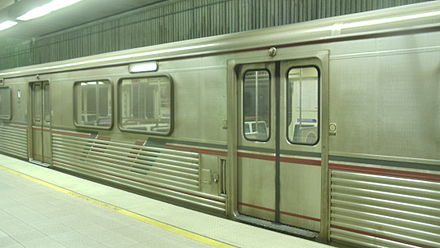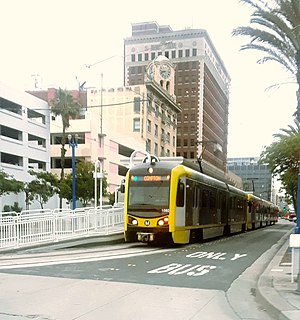| Station | Connections | Date Opened | Station Parking | City/ Neighborhood |
|---|
| Union Station |  B Line (Red) B Line (Red)  L Line (Gold) L Line (Gold)  J Line (Silver) J Line (Silver) - Metro Local: 40, 68, 70, 71, 76, 78, 79, 378
- Metro Express: 442, 485, 487, 489
- Metro Rapid: 704, 728, 733, 745, 770
- Amtrak: Coast Starlight, Pacific Surfliner, Southwest Chief, Sunset Limited/Texas Eagle, San Joaquin (Bus Connection)
- Antelope Valley Transit Authority: 785
- City of Santa Clarita Transit: 794
- Foothill Transit: Silver Streak, 493, 497, 498, 499, 699
- LAX FlyAway
- LADOT Commuter Express: 431, 534
- LADOT DASH: B, D, Lincoln Heights/Chinatown
- Metrolink: Antelope Valley Line, Ventura County Line, San Bernardino Line, Riverside Line, Orange County Line, 91 Line
- Orange County Transportation Authority: 701
- Santa Monica Big Blue Bus: Rapid 10
- Torrance Transit: 4
| January 30, 1993 | Nearby Paid Parking (Independent) | Downtown
Los Angeles |
| Civic Center/Grand Park |  B Line (Red) B Line (Red)  J Line (Silver) J Line (Silver) - Metro Local: 2, 4, 10, 14, 28, 30, 37, 40, 45, 48, 68, 70, 71, 76, 78, 79, 81, 83, 90, 91, 92, 94, 96, 302, 378
- Metro Express: 442, 487, 489
- Metro Rapid: 728, 733, 745, 770, 794
- Antelope Valley Transit Authority: 785
- City of Santa Clarita Transit: 799
- Foothill Transit: Silver Streak, 493, 495 497, 498, 499, 699
- LADOT Commuter Express: 409, 419, 422, 423, 431, 437, 438, 448, 534
- LADOT DASH: A, B, D
- Montebello Bus Lines: 341, 342
- Santa Monica Big Blue Bus: Rapid 10
- Torrance Transit: 4
| Nearby Paid Parking (Independent) |
| Pershing Square |  B Line (Red) B Line (Red)  J Line (Silver) (northbound only) J Line (Silver) (northbound only)- Metro Local: 2, 4, 10, 14, 16, 18, 28, 30, 33, 37, 38, 40, 45, 48, 53, 55, 62, 68, 70, 71, 76, 78, 79, 81, 83, 90, 91, 92, 94, 96, 302, 316, 378
- Metro Express: 442, 487, 489
- Metro Rapid: 728, 733, 745, 770, 794
- Angels Flight
- Foothill Transit: Silver Streak
- LADOT Commuter Express: 409
- LADOT DASH: B, D
- Montebello Bus Lines: 40, 50, 341, 342
- Orange County Transportation Authority: 701, 721
- Torrance Transit: 4 (northbound only)
| Nearby Paid Parking (Independent) |
| 7th Street/Metro Center |  A Line (Blue) A Line (Blue)  B Line (Red) B Line (Red)  E Line (Expo) E Line (Expo)  J Line (Silver) J Line (Silver) - Metro Local: 14, 16, 18, 20, 37, 51, 52, 60, 62, 66, 76, 78, 79, 81, 316, 352, 378
- Metro Express: 442, 460, 487, 489
- Metro Rapid: 720, 760
- Antelope Valley Transit Authority: 785
- City of Santa Clarita Transit: 799
- Foothill Transit: Silver Streak, 493, 495, 497, 498, 499, 699
- LADOT Commuter Express: 409, 422, 423, 431, 437, 438, 448, 534
- LADOT DASH: A, B, E, F
- Montebello Bus Lines: 40, 50, 90, 341, 342
- Orange County Transportation Authority: 701, 721
- Santa Monica Big Blue Bus: Rapid 10
- Torrance Transit: 4
| None |
| Westlake/MacArthur Park |  B Line (Red) B Line (Red) - Metro Local: 18, 20, 51, 52, 200, 352, 603
- Metro Express: 487, 489
- Metro Rapid: 720
- LADOT DASH: Pico Union/Echo Park
| None | Westlake |
| Wilshire/Vermont |  B Line (Red) B Line (Red) - Metro Local: 18, 20, 51, 52, 201, 204, 352
- Metro Rapid: 720, 754
- LADOT DASH: Wilshire Center/Koreatown
| July 13, 1996 | Nearby Paid Parking (Independent) | Mid-Wilshire
Koreatown |
| Wilshire/Normandie | - Metro Local: 18, 20, 206
- Metro Rapid: 720
| None |
| Wilshire/Western | - Metro Local: 18, 20, 66, 207, 209
- Metro Rapid: 710, 720, 757
- LADOT DASH: Hollywood/Wilshire, Wilshire Center/Koreatown
- Santa Monica Big Blue Bus: 7, Rapid 7
| None |
Wilshire/La Brea
(under construction) | | 2023 | None | Miracle Mile |
Wilshire/Fairfax
(under construction) | | Beverly Grove |
Wilshire/La Cienega station
(under construction) | | Beverly Hills |
Wilshire/Rodeo
(under construction) | | 2025 |
Century City/Constellation
(under construction) | | Westwood |
Westwood/UCLA
(under construction) | | 2027 |
Westwood/VA Hospital
(under construction) | |



















